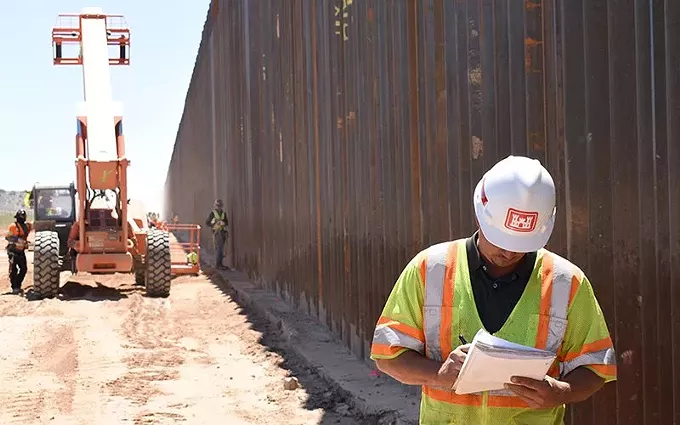Tucson journalist Todd Miller opens his newest book with an encounter he had with an undocumented immigrant in the Arizona desert about 20 miles from U.S-Mexico border.
Miller offered Juan Carlos water and asked if he needed anything else. Juan Carlos asked him for a ride and, while Miller's first instinct was to help the man, he experienced what he calls "wall sickness." He hesitated when he remembered his kindness would be considered a federal crime. At the same time, he thought the bigger crime would be leaving a man to possibly die in the desert.
"Why am I compelled to be complicit either with enforcing authoritarian law or with upholding our common humanity, with building a wall or building a bridge?" Miller asks himself in Build Bridges, Not Walls: A Journey to a World Without Borders.
"In a lot of ways [the book] is a meditation on the fact, 'Why did I hesitate in that moment?' It's also a meditation on these years of reporting on the border and just kind of even a reflection of those years," said Miller.
This week's excerpt from the book takes Miller from a shelter in Nogales to conventions where corporations try to convince government agencies to purchase "solutions" to border security issues.
With 15 years of experience as an immigration journalist, Miller has investigated the increased spending on militarization, security and fortification. At the time of the fall of the Berlin Wall, he said there were 15 border walls in existence; today, there are more than 70 walls around the world.
Writing most of the book during the pandemic last year, Miller found the novel coronavirus showcased the inability of borders to deal with global issues.
"Part of COVID-19's potent message is that everything can change at a moment's notice," Miller wrote. "Hierarchies can suddenly clash and reorganize. Perhaps the pandemic has brought humanity to something that has been needed for a long time: a new frontier."
Miller acknowledges that his new frontier—a borderless world—is an idea that most people dismiss, including politicians on both sides of the aisle, who say a borderless world would cause chaos. Miller wonders if that's a myth.
"It was like night and day. All of a sudden the border is sealed there," said Miller. "Why can't you do it the opposite way? Like Operation Un-hold the Line, but anyhow, that's not even in the conversation right?"
Miller finds "wall sickness"—a term first used to describe the heightened feeling of anxiety felt by German people living near the Berlin Wall—extends beyond the border now. The narrowness felt from the "internationalization of the wall into the people's psyche" could be seen in Border Patrol agents, who do not allow people to touch the wall, or a person in Kansas, far from the border, who may tout "Build the wall" because they believe someone will take their job or food.
"I would argue that is an internalization of something, and maybe in this sense, it's more mythical right," said Miller. "The same sort of set of mistaken values, I would say. What is really needed for humankind? What is really a threat?"
Miller quotes Admiral Samuel J Locklear III, commander of the U.S. Pacific Command, who said global warming was the greatest threat the U.S. faced because of mass destabilization.
"The real threat, the biggest existential threat that faces humanity, or one of them, is this rapidly changing climate and that's what every scientist is saying," Miller says. "And yet you don't put enough resources into that, instead you build up your borders. And it just makes absolutely no sense. It needs a global solution. It doesn't need more divisions between people. It needs people to come together to come up with some sort of solutions and broad strokes and also in very local strokes."
Thus Miller goes on a journey to consult with philosophers, religious and political figures, migrants and his own child, William, to guide the reader through his own questions and explore a world beyond what we are accustomed to.
Miller explores the idea of sanctuary and transgression through Nigerian thinker Bayo Akomolafe, the Franciscan concept of "overflowing love" from Brother David Bauer and the Zapatistas' view of the world and the fight to achieve it.
While he offers no set solutions, at the heart of Miller's 's book is an impulse toward a humble civil disobedience or abolition through acts of kindness.
Miller quotes Argentine revolutionary Che Guevara: "At the risk of seeming ridiculous let me say a true revolutionary is guided by a great feeling of love."
"What I think needs to be done are the imaginations need to be opened and I'm not even suggesting I know what to do," Miller says. "What I am suggesting is that me and you talk, maybe our conversation can bring up all these ideas and we bring other people in, regular people, the people most impacted especially and then, we all talk together.
As he wrote the book, Miller watched various moments of social unrest, including the unfolding of the Black Lives Matter movement. Miller believes in the change from the bottom up and the power of interconnectivity.
"If somebody hears abolition, they might think, 'Oh, that means going and tearing down something,' or it might mean like a violent act of some sort and really it's the exact opposite," says Miller. "It could be like many things, right? It could be you in an organization. It could be you doing some sort of civil disobedience on a big scale or it could be like you deciding to be kind to somebody that you wanted to be mean to."
Miller finds borders to be anti-empathetic, thriving on the idea of "us versus them," so the person in Kansas who has never seen the border thinks there are bad people on the other side, "which just naturally makes them inclined not to think about their lives at all."
At an event for this book in Patagonia, Miller met someone who tried to support his idea of a wall by talking about his experience with Columbians in New York. Miller suggested the man travel 10 to 20 minutes to the Nogales border crossing to meet and talk to people.
"I think that is really effective, the more that people could go and talk to people that have been otherized, maybe even subconsciously by them, through the ways that people get depicted, and just break through those boundaries," Miller says. "I think that brings the walls down too."
When imaging a world with bridges instead of walls, Miller also consulted his now 5-year-old son William. William called Border Patrol agents "green men,' indulged in his own act of civil disobedience when he playfully peed on the wall and asked his father why the steel bollards couldn't be turned into bikes.
"I think that captures the spirit of what I was trying to say with this book, actually," Miller says.












